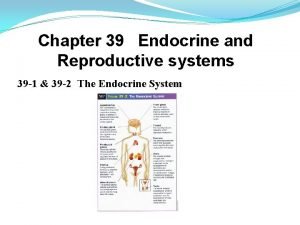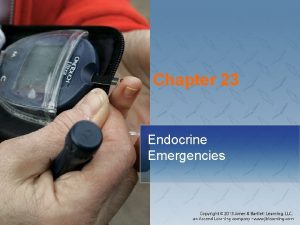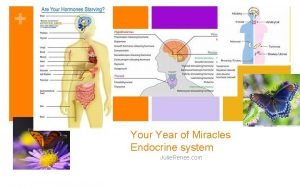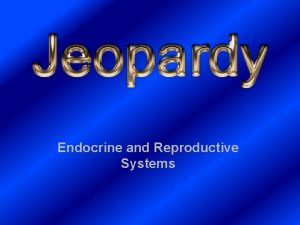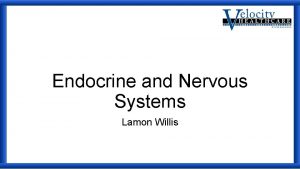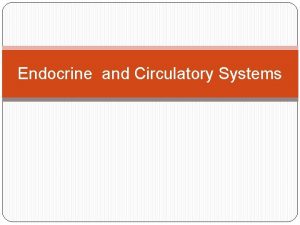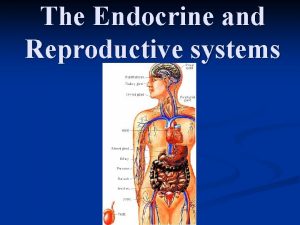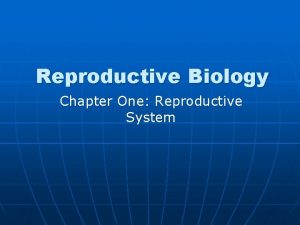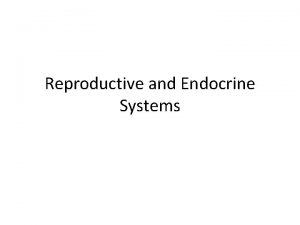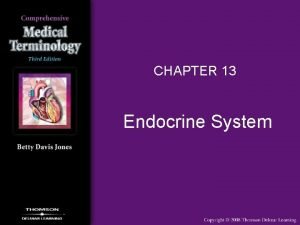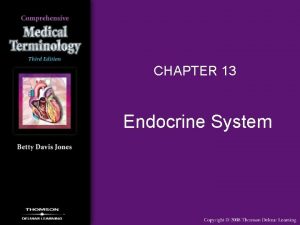Chapter 39 Endocrine and Reproductive systems 39 1














- Slides: 14

Chapter 39 Endocrine and Reproductive systems 39 -1 & 39 -2 The Endocrine System

• The Endocrine System is a regulatory system which works very closely with the Nervous System to maintain homeostasis • It is made up of glands that release their products into the bloodstream • A gland is an organ that produces a substance that is secreted • These chemical products or secretions, called hormones, carry messages throughout the body • Hormones travel throughout the bloodstream and affect the activities of other cells • They do this by binding to receptors on the cells that respond; these cells are called target cells

Control of the Endocrine System • The Endocrine system is regulated by feedback mechanisms that function to maintain homeostasis • Feedback inhibition occurs when an increase in any substance inhibits the process that produced that substance (remember…. heating and cooling systems) • See example below of how the hormone released by the thyroid gland is regulated Notice how an increase in TSH causes the release of thyroxine. As the level of thyroxine increases in the blood, the level of TSH decreases. This action causes a decrease in thyroxine, which causes an increase in TSH, and the cycle begins again


39 -3 The Reproductive System • Reproduction is the formation of new individuals • The reproductive system produces, stores, and releases specialized sex cells called gametes • These sex cells (egg and sperm) fuse together to form a zygote which is the single cell from which all cells of the human body develop

The Male Reproductive System • The main structures of this system are: testes, epididymis, vas deferens, urethra, and the penis • These structures work together to produce and deliver sperm • About 200 -600 million sperm are released with each ejaculation making the chances of a single sperm fertilizing an egg quite good

The Female Reproductive System • The main structures of this system are: ovaries, fallopian tubes, uterus, and the vagina • In addition to producing eggs, the female reproductive system prepares the female’s body to care for and protect the developing embryo • The ovaries produce only one fertile egg each month • Each female is born without about 400, 000 immature eggs, but only about 400 mature eggs are released during her reproductive life


The Menstrual Cycle • During the menstrual cycle the egg develops and is released from the ovary • In addition, the uterus is prepared to receive a fertilized egg • If an egg is not fertilized, it is discharged along with the uterine lining • The cycle is divided into 4 phases during which there are changes in hormone levels, the follicle develops, and the uterine lining changes

Phases of the Menstrual Cycle

39 -4 Fertilization and Development • The process of a sperm joining an egg is called fertilization • The fertilized egg is called a zygote and it undergoes cell division (mitosis) to produce an embryo • This cluster of cells attaches itself to the wall of the uterus and continues to divide

Fertilization

• By the end of the third week, an important organ called the placenta has begun to form • The placenta is an organ of exchange between the mother and the embryo • It is where the embryo gets its oxygen and nutrients and excretes its waste products

• The placenta acts as a barrier to harmful or diseasecausing organisms • However, some (German measles) can penetrate and affect development and so can alcohol and some prescription medications.
 Chapter 39 endocrine and reproductive systems
Chapter 39 endocrine and reproductive systems Endocrine system and reproductive system
Endocrine system and reproductive system The body's speedy electrochemical communication network
The body's speedy electrochemical communication network Chapter 36 section 2 human development before birth
Chapter 36 section 2 human development before birth Chapter 46 digestive and endocrine disorders
Chapter 46 digestive and endocrine disorders Oxication
Oxication Chapter 29 endocrine and metabolic disorders
Chapter 29 endocrine and metabolic disorders Chapter 19 endocrine and hematologic emergencies
Chapter 19 endocrine and hematologic emergencies Hormones
Hormones Chapter 16 matching questions 20-24
Chapter 16 matching questions 20-24 Chapter 7:13 endocrine system
Chapter 7:13 endocrine system Chapter 11 endocrine system
Chapter 11 endocrine system Pituitary
Pituitary Endocrine reboot chapter
Endocrine reboot chapter Chapter 16 lesson 3 the female reproductive system
Chapter 16 lesson 3 the female reproductive system
